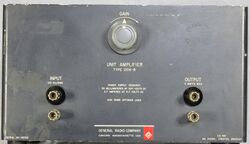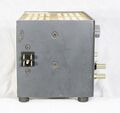1206-B: Difference between revisions
Jump to navigation
Jump to search
No edit summary |
No edit summary |
||
| (3 intermediate revisions by one other user not shown) | |||
| Line 1: | Line 1: | ||
{{GR Product | {{GR Product | ||
|model=1206-B | |model=1206-B | ||
|codes=ARBOR,1206-9702 | |||
|class=detectors amplifiers | |class=detectors amplifiers | ||
|summary=Unit Amplifier | |summary=Unit Amplifier | ||
| Line 10: | Line 11: | ||
|designers= | |designers= | ||
|manuals= | |manuals= | ||
* [[Media:GR 1206-B Unit Amplifier 1206-0100-E 01_1962.pdf|General Radio 1206-B Unit Amplifier Manual 1206-0100-E 1962]] | |||
* [[Media:GR 1206-B Unit Amplifier 825-C 10_1957.pdf|General Radio 1206-B Unit Amplifier Manual 825-C October 1957]] | * [[Media:GR 1206-B Unit Amplifier 825-C 10_1957.pdf|General Radio 1206-B Unit Amplifier Manual 825-C October 1957]] | ||
{{Catalog History}} | {{Catalog History}} | ||
| Line 15: | Line 17: | ||
The {{Title|General Radio 1206-B Unit Amplifier}} was introduced in {{Catalog N}} and remained available through {{Catalog S}}. | The {{Title|General Radio 1206-B Unit Amplifier}} was introduced in {{Catalog N}} and remained available through {{Catalog S}}. | ||
The Type 1206-B is a unit style general purpose amplifier | The Type 1206-B is a [[Unit instruments|unit-style]] general-purpose amplifier for frequencies up to 500 kHz. The recommended power supplies are the Types [[1201-A]], [[1203-B]] and [[1204-B]] (adjusted to 300 V). | ||
The 1206-B can deliver 3 watts of output power with reduced frequency response, and 1.5 watts with excellent audio response. With low hum and high gain, it is well suited for audio and ultrasonic laboratory use. | |||
The circuit is a transformerless push-pull amplifier with a pair of 6W6-GT tubes in the output, driven by a 12AX7 whose two systems are used as a 1st gain stage and a phase splitter stage, respectively. | |||
==Specifications== | ==Specifications== | ||
* '''Frequency Response:''' 2 Hz | * '''Frequency Response:''' 2 Hz to 500 kHz at 10 V (or less) output, down ≤3 dB | ||
* '''Load Impedance:''' 600 Ω optimum | * '''Load Impedance:''' 600 Ω optimum | ||
* '''Input Impedance:''' 100 kΩ in parallel with 35 pF | * '''Input Impedance:''' 100 kΩ in parallel with 35 pF | ||
* '''Power Output:''' 10 Hz to 50 kHz, 3 W; 5 Hz to 100 kHz, 1.5 W; | * '''Power Output:''' 10 Hz to 50 kHz, 3 W; 5 Hz to 100 kHz, 1.5 W; 250 kHz, 0.5 W | ||
==Links== | ==Links== | ||
* [[Media:GR Exp 1206-B 11_1953.pdf|Experimenter describing Type 1206-B | * [[Media:GR Exp 1206-B 11_1953.pdf|Experimenter November 1953 describing Type 1206-B]] | ||
* [https://www.pa4tim.nl/?p=4982 GR 1206-B @ PA4TIM Fred's pages] | * [https://www.pa4tim.nl/?p=4982 GR 1206-B @ PA4TIM Fred's pages] | ||
Latest revision as of 08:53, 15 October 2024
The General Radio 1206-B Unit Amplifier was introduced in Catalog N (1954) and remained available through Catalog S (1965).
The Type 1206-B is a unit-style general-purpose amplifier for frequencies up to 500 kHz. The recommended power supplies are the Types 1201-A, 1203-B and 1204-B (adjusted to 300 V).
The 1206-B can deliver 3 watts of output power with reduced frequency response, and 1.5 watts with excellent audio response. With low hum and high gain, it is well suited for audio and ultrasonic laboratory use.
The circuit is a transformerless push-pull amplifier with a pair of 6W6-GT tubes in the output, driven by a 12AX7 whose two systems are used as a 1st gain stage and a phase splitter stage, respectively.
Specifications
- Frequency Response: 2 Hz to 500 kHz at 10 V (or less) output, down ≤3 dB
- Load Impedance: 600 Ω optimum
- Input Impedance: 100 kΩ in parallel with 35 pF
- Power Output: 10 Hz to 50 kHz, 3 W; 5 Hz to 100 kHz, 1.5 W; 250 kHz, 0.5 W







